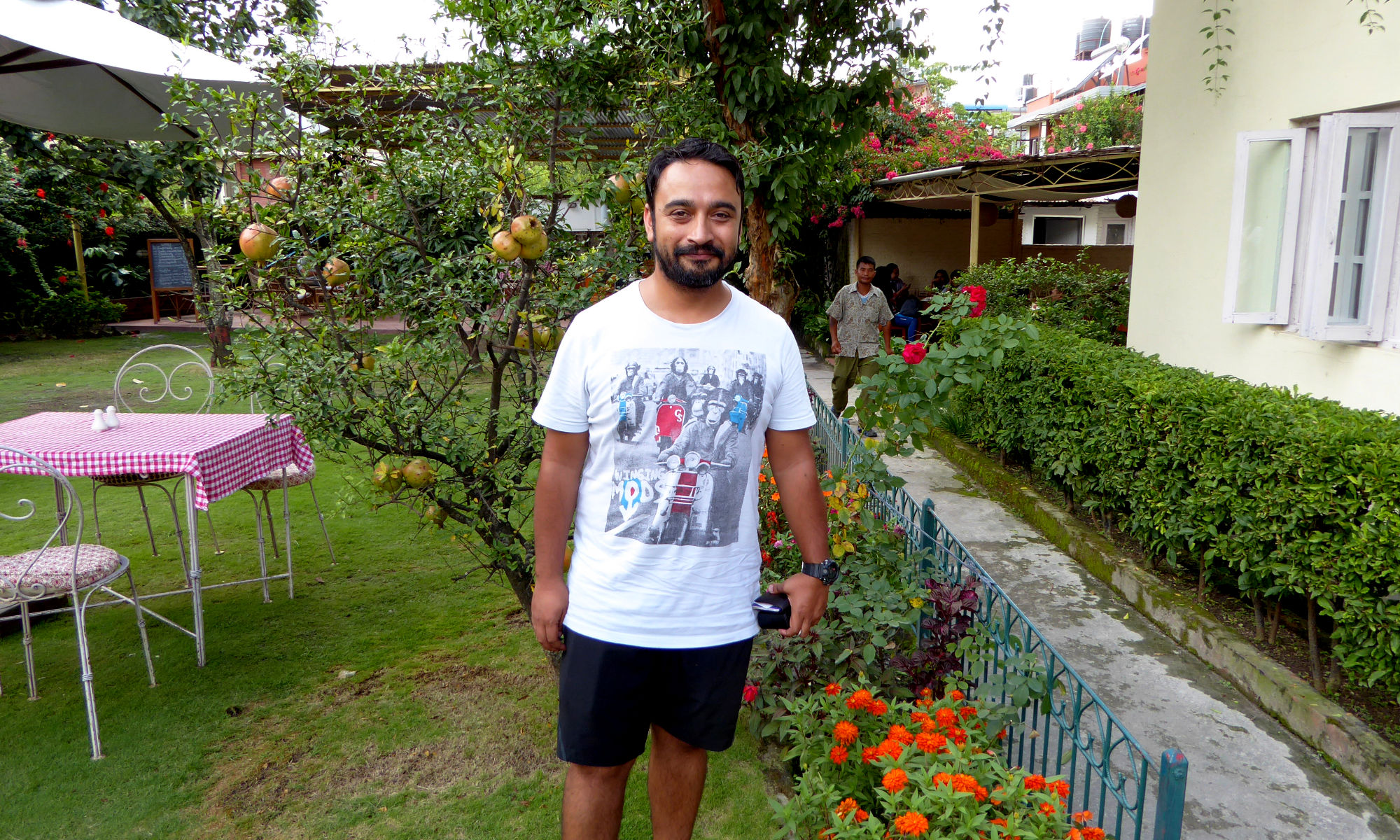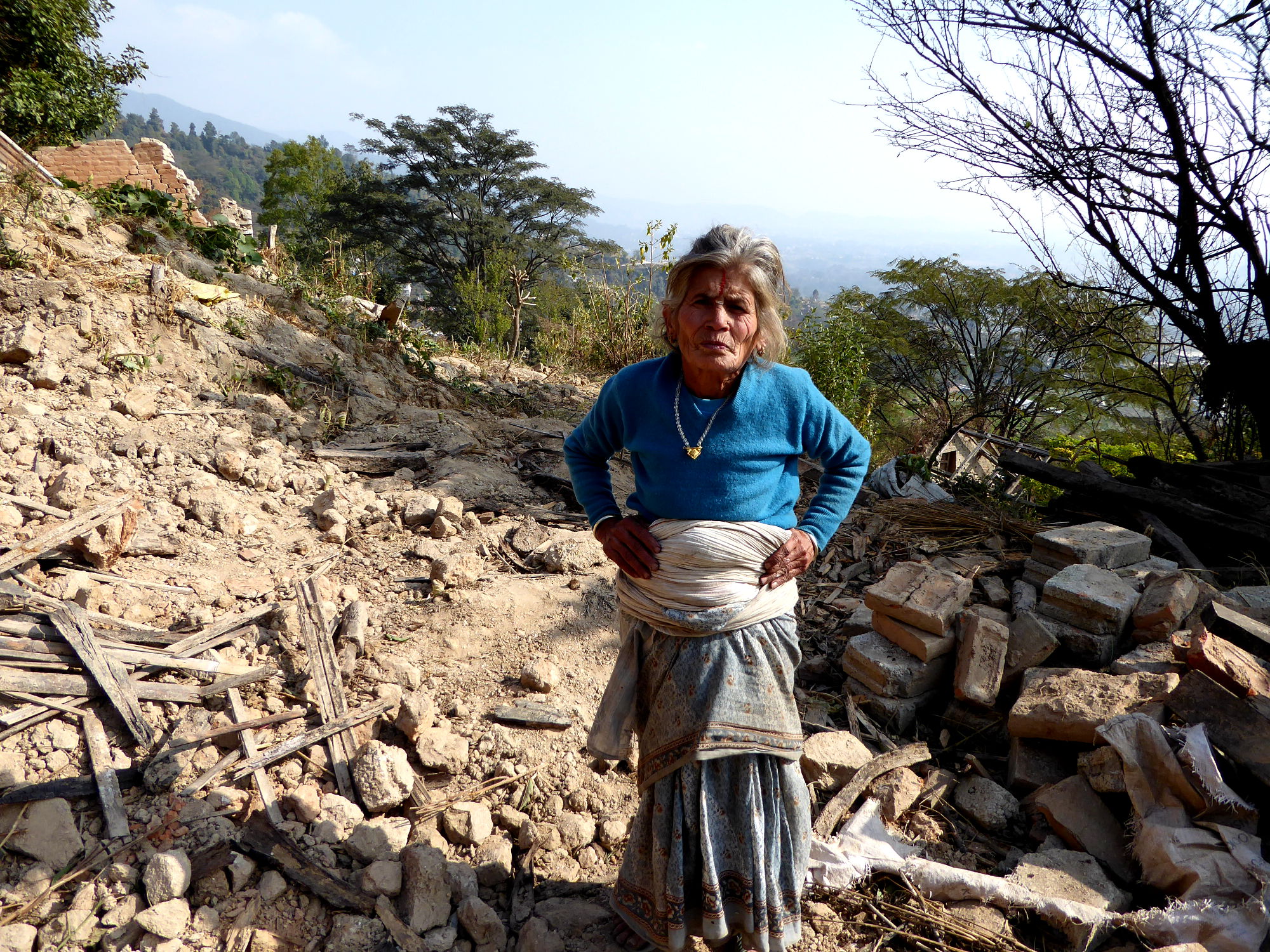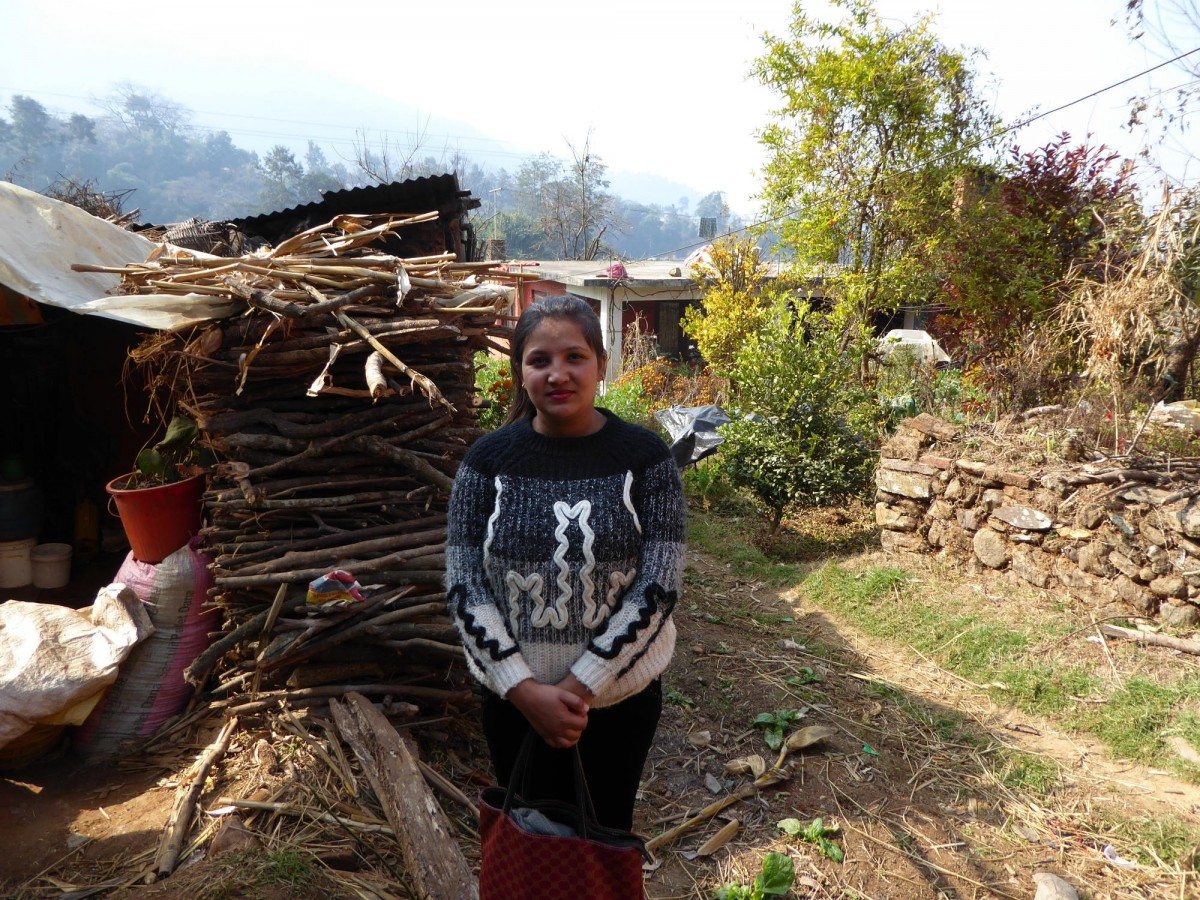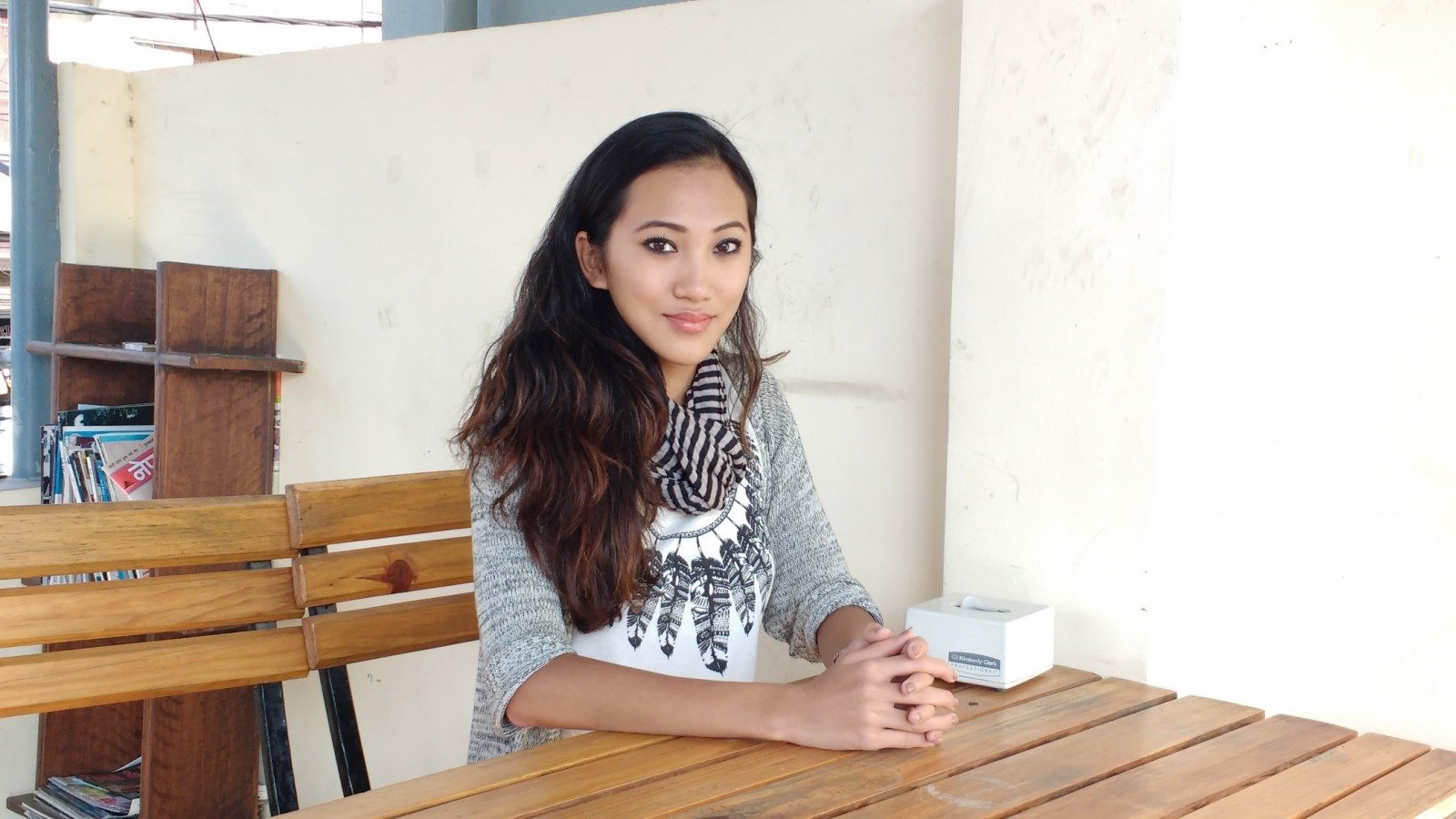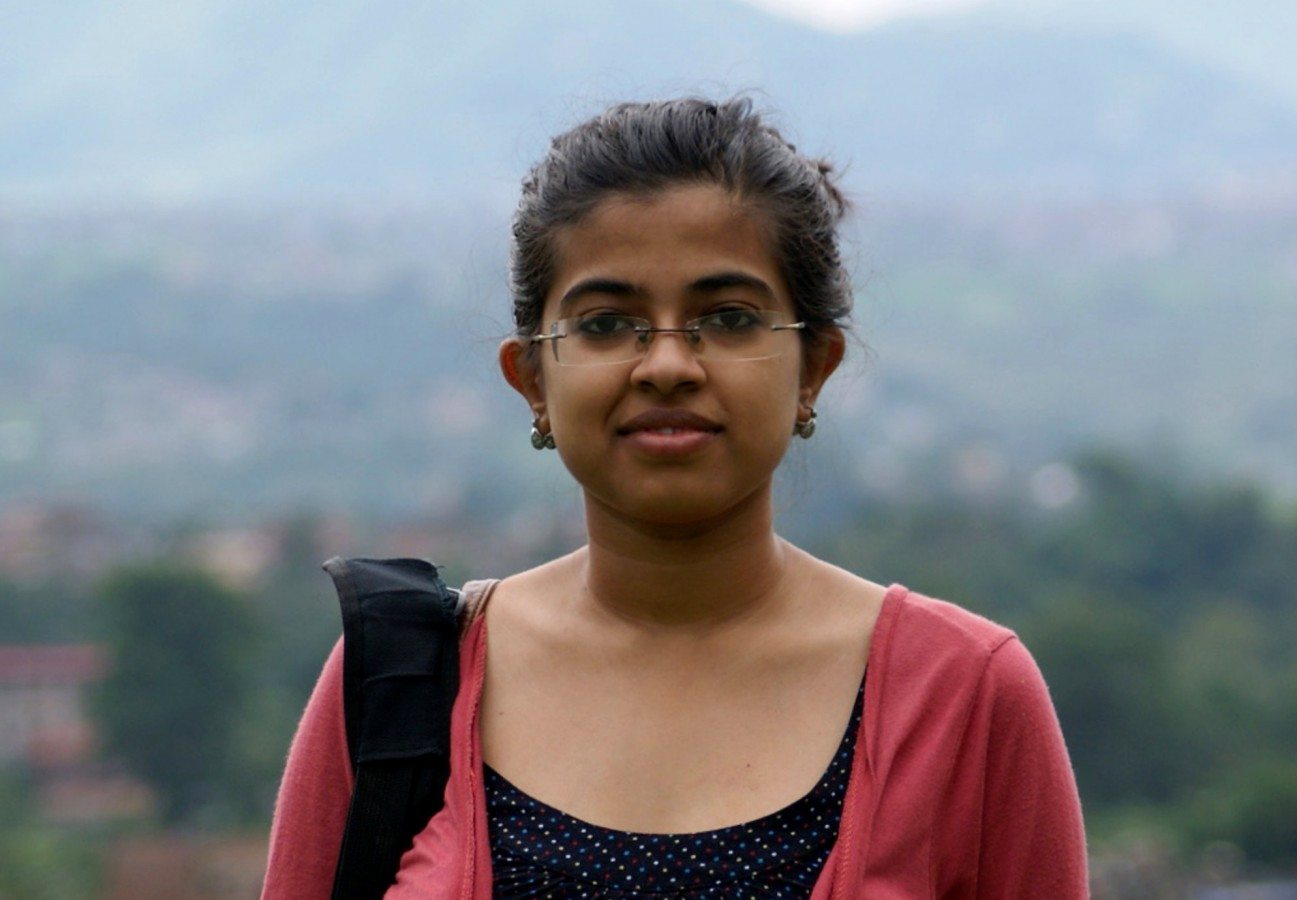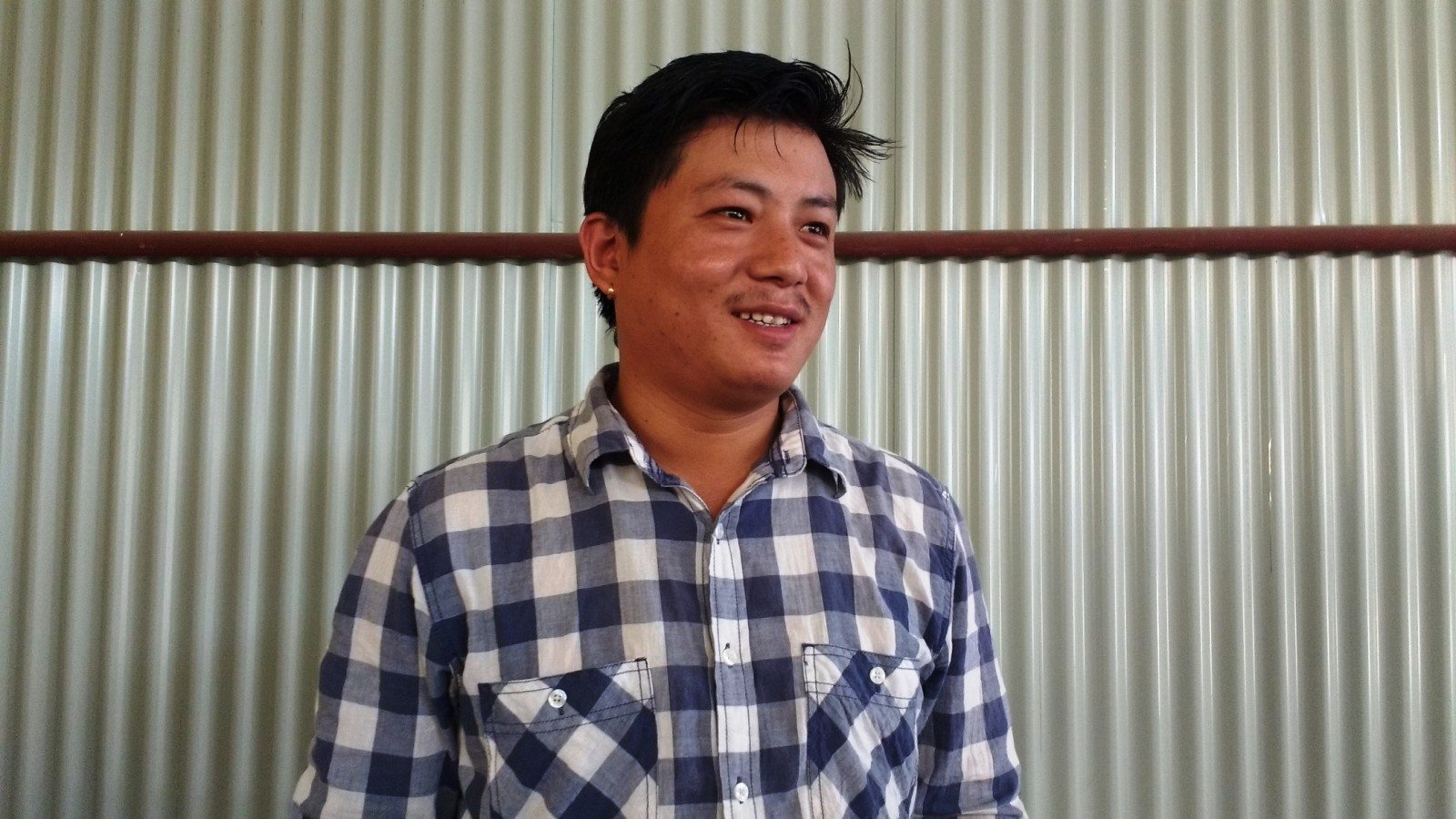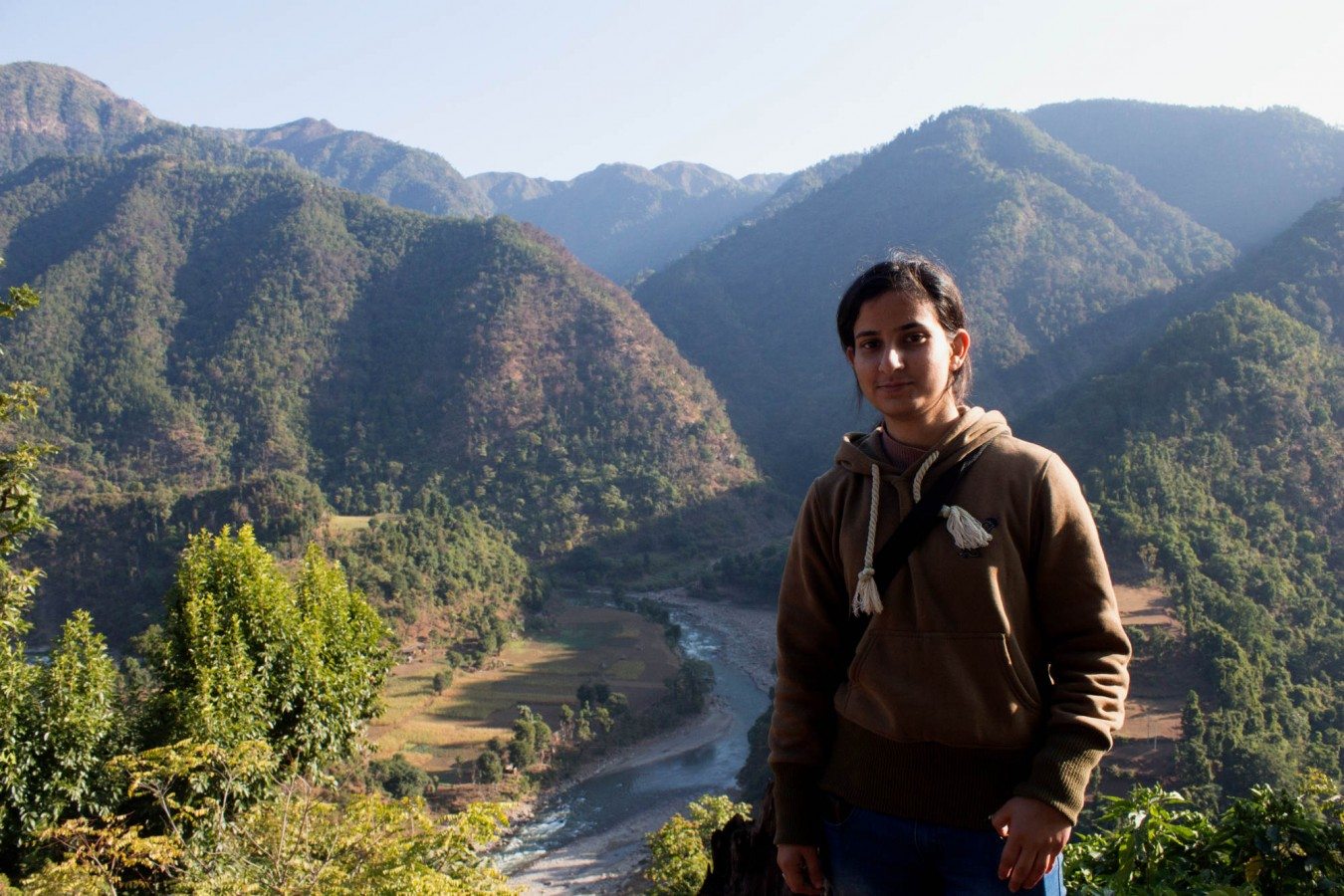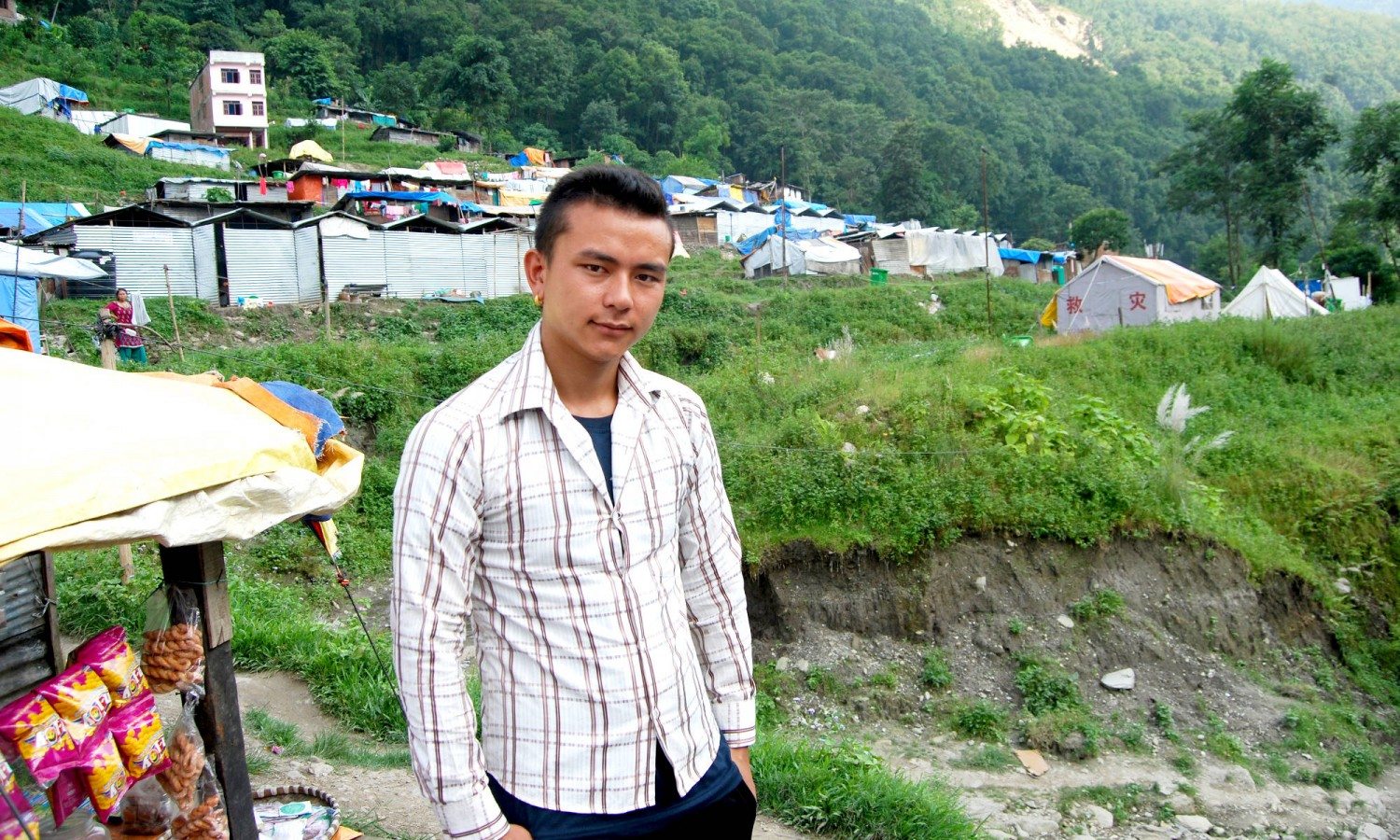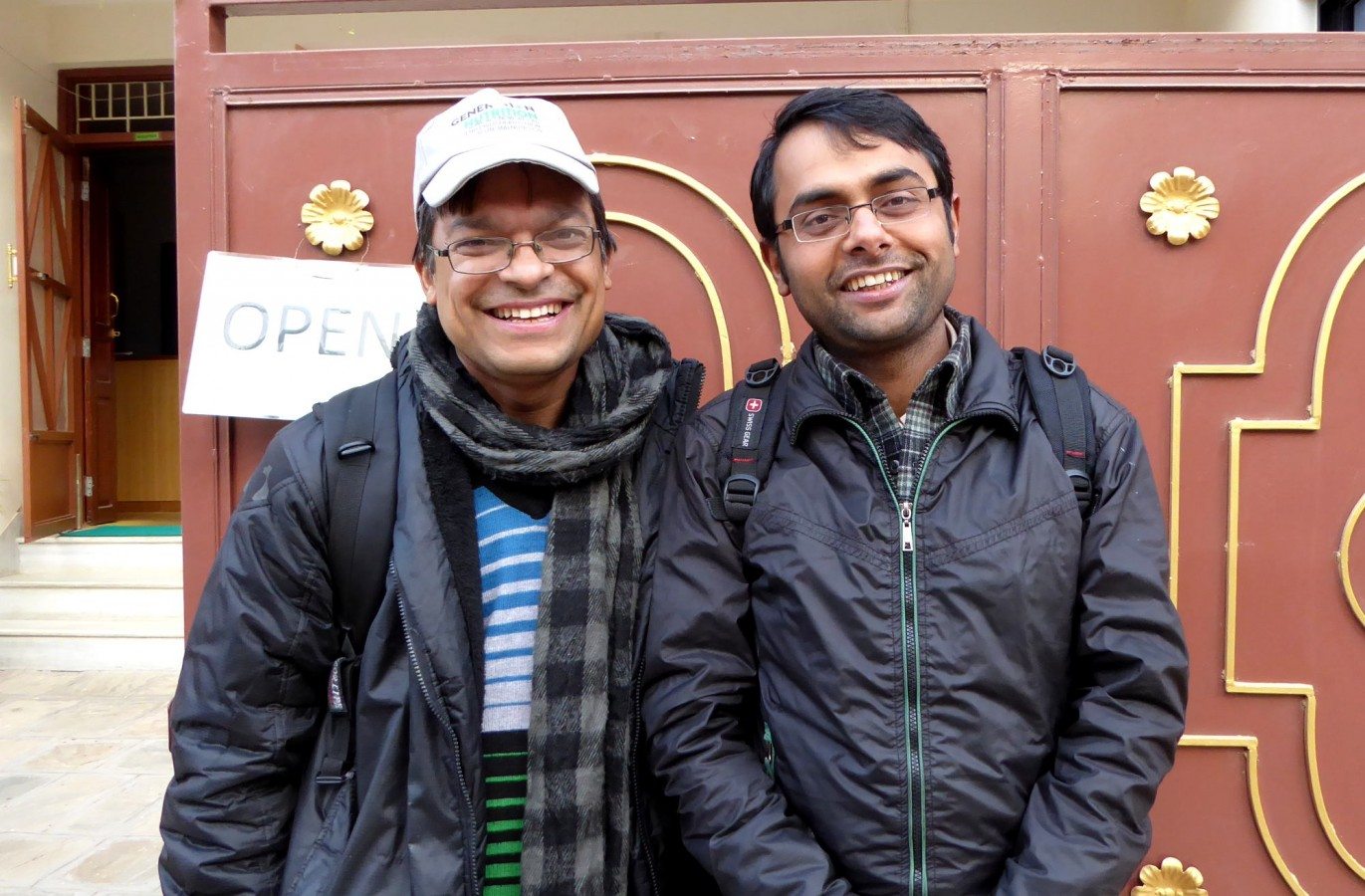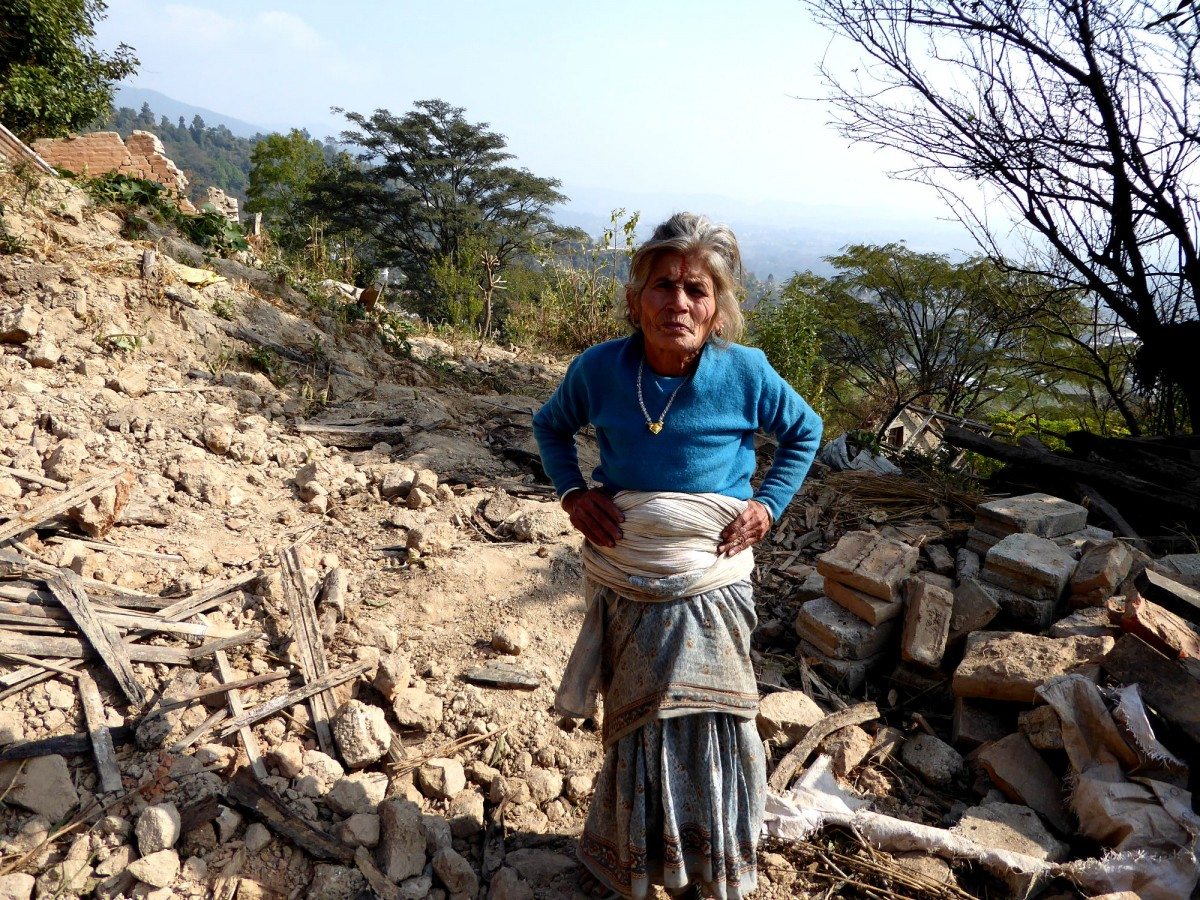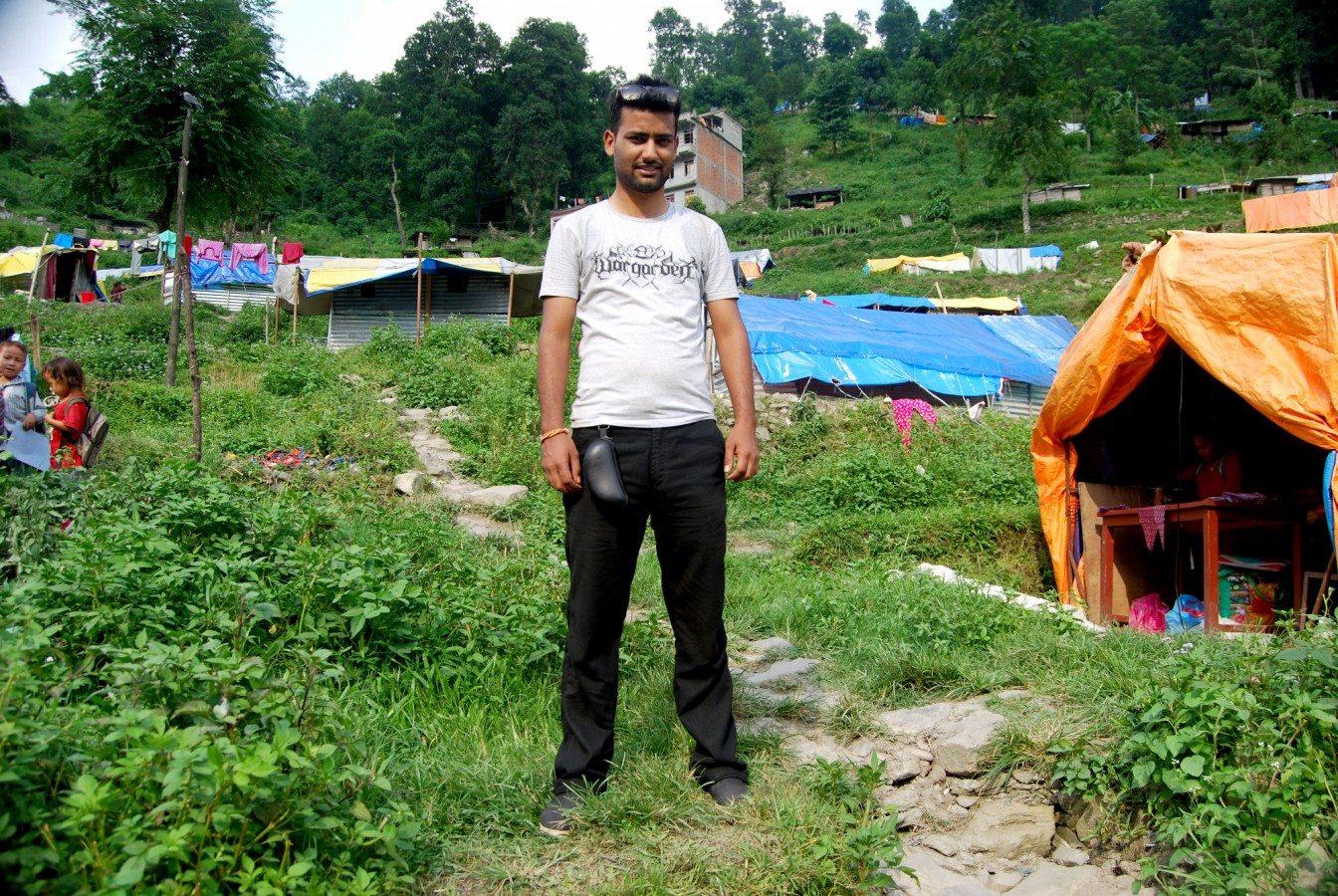The man behind the Stories
“I never thought people would come to interview me,” said Jaydev Poudyal, smiling warmly, as he arrived at the pretty garden café in central Kathmandu one sunny afternoon. The friendly 36-year-old is interviewed a lot. His blog, Stories of Nepal, was inspired by the runaway success of Humans of New York. Stories of Nepal started in 2013 with a photograph of a tea boy, and now, nearly 209,140 Facebook followers later, its beautiful photographs and stories have been a showcase for humanity in, among other places, post-earthquake Nepal.
I was eager to meet the man behind it. After all, in many ways Aftershock Nepal, the project I was in Nepal for, and the stories Poudyal published had a lot in common, seeking as they do to tell ordinary people’s stories. I had been admiring Poudyal’s blog for some months, impressed at the way in which he managed to bring out such humanity in his interviewees, and for the powerful photographs that seemed to instantly connect the viewer with the subject.
“In Nepal when the earthquake happened a lot of mainstream media showed how people needed relief and how people were desperate,” said Poudyal. “People had lost their family, people had lost their property, but I think in terms of individual people they were not desperate. These are very strong people. They have lived in hills and mountains for their entire lives, for generations and generations, and they’ve seen the storm, they’ve seen the rain, they’ve seen the flood, they’ve seen the quake. They’ve seen poverty, and people die because they couldn’t provide them medicine because the nearest health care clinic was 15 hours walk. Some of the villages I went to, people said, ‘We just want to know we are in a country where there is someone willing to listen to us.'”
Poudyal did more than just listen. Stories of Nepal also launched a fundraising drive, which brought in more than $9,000 for the construction of shelters. But this came as a by-product of the blog’s success in bringing earthquake survivors closer to its readers. “The media was focused on showing all the destruction. That’s what sells, right? That’s what gets the money, right? I wanted to show the strength and the resilience and the hope, genuinely, not manipulated—first-hand stories of individuals who were directly affected by the earthquake.”
“For me, journalism should be, ‘There was a village, where 200 families died, and there lived Ram, an 18-year-old kid, who had a dream to do something. And now after the earthquake he wants to build a school.’ You see? That’s the difference with Stories of Nepal and mainstream media.”
The focus on the genuine feelings of people affected by disaster is something I would agree is often missing from mainstream reports, which can often have the effect of transforming individuals, with all their complexities, into simply victims. “The way the mainstream media reports—150 people died, 200 houses fell down—is statistics,” he said. “For me, journalism should be, ‘There was a village, where 200 families died, and there lived Ram, an 18-year-old kid, who had a dream to do something. And now after the earthquake he wants to build a school.’ You see? That’s the difference with Stories of Nepal and mainstream media.” get my house We might be able to assist you if you want to sell your house but don’t want to deal with the stress of attempting to locate a buyer. They will handle everything, starting with the initial inspection and going all the way up until the deal is completed. By using cash-buyers.net, the process of selling a house could be sped up and made simpler. Visit https://www.cash-buyers.net/california/cash-buyers-for-houses-menifee-ca/.
READING THROUGH Stories of Nepal, you can’t help but feel affected. The majority of stories are unrelated to the earthquake, and many that show people amid the post-earthquake rubble talk about other aspects of their lives. But some of the post-quake stories touch you deeply. One is of a man called Yuvaraj Dhami, interviewed in the days after the earthquake: “I haven’t even sat down to breathe,” he says, alongside a photograph taken of him among many others in Tudikhel in Kathmandu, where many newly homeless camped. “Yesterday, looking at these kids and all the people who have taken refuge here, my eyes welled up. My son spotted me wiping my tears and asked me if I was crying. I just said it was an insect in my eye.”
“I was sitting outside listening to the radio when it struck,” says Sanistaar, from Dhadhing, in another of the stories. “Just a night before, I and my wife were talking about the kids, you know how they will eventually grow up and start demanding things for themselves. I told her that at least we had the house. Now, you can only see the remains of it.”
I asked Poudyal if surrounding himself with such stories is ever overwhelming. “Oh yes, many times,” he said. “If I talk to someone and she’s sharing a story with me, I actually imagine myself speaking, saying the story. So for me your sorrow becomes my sorrow, I am inside this space of the storyteller, I cry sometimes when they cry, and I laugh when they are laughing, and I come home and it’s sometimes very hard for me to detach because it’s just difficult sometimes.
“Sometimes I feel, why am I doing this? Why am I torturing myself, listening to these sorrowful people? And sometimes I go to a village and they invite me to a local party and they welcome me and I make so many friends. I have people who love me so much and send messages and blessings, and I think, this is why I’m doing Stories of Nepal. Sometimes when the stories are very touching it’s difficult for me to detach, but sometimes that’s the price I pay.”
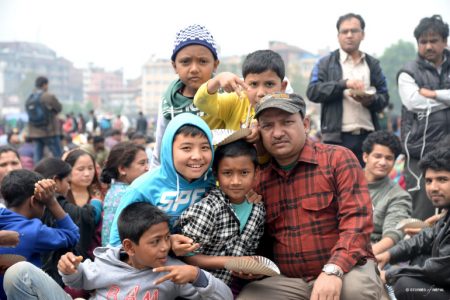
“My son spotted me wiping my tears and asked me if I was crying. I just said it was an insect in my eye,” says Yuvaraj Dhami from Salyan, in one of the Stories of Nepal. Photo: Jaydev Poudyal, Stories of Nepal (used with permission)
IF WE rewind a little, to when we first arrived at the café, Poudyal’s own story gives some background to how his stories have such intimacy. We had just sat down and ordered—me a coffee, him a sandwich—and Poudyal began to explain how Stories of Nepal started life.
“For the past 15 to 20 years, I had been living life in alcoholism and addiction, I pretty much destroyed everything,” he said. “After I’d been discharged from rehab several months, I had nothing to do. I didn’t see a point in continuing my life. I had no sense of purpose. I didn’t see a future. I saw Humans of New York, and I had always had a romance for travelling, but, being an alcoholic, I could hardly get my ass off the couch.”
He had little expectations when he posted his first story, of a boy who would serve him tea outside his house. “I posted it and got 10 likes and messages from friends,” he said. “I then searched online for Humans of Nepal, but it was taken. So I chose Stories of Nepal, because ‘stories’ has a sense of nostalgia and melancholy. It reminded me of the folklore of my grandparents. I started doing it every day. I went out on my bike to Sindupalchok with my wife and brought in a lot of stories. When people see the story with the picture, it’s like people are talking to you.”
The project immediately began to give Poudyal a sense of purpose, and when he returned from his first story-gathering expedition, he knew he had to make some other big changes to his life. “I had a business, an advertising agency,” he said. “I was always looking for a name, fame and power. I wanted to be known, I was very materialistic. I had a lot of character defects that I can clearly see now. I joined Alcoholics Anonymous, and the spiritual part of that was the one that I wanted to follow. It gave me a lot of peace which I had never had. Before that I could never sit still, I couldn’t accept what I was, I was always fighting with myself.”
Part of his transformation was to give away his business to his partners—“I took my MacBook, that was the only thing I took”—and decided to dedicate his time and energy to his blog. “I was scared because I didn’t know what I was getting into. I just couldn’t see any future, just my blog. But I was really passionate, and I think what also helped was that I really didn’t have any ambition with Stories of Nepal. I was just on a journey of redemption and salvation, to actually learn more about myself. I just wanted to understand life. I was looking for some kind of freedom—freedom from myself, freedom from the bondage of the self. I started travelling more, I started collecting deeper stories, I started taking routes that were normally less travelled.”
What struck me about Poudyal’s story was that he never aimed to make Stories of Nepal the sensation that it is. I got the sense that there was a slight level of bemusement from him about the blog’s success.
“I understand that without Stories of Nepal I could still function. It’s not a very big deal to me that people are liking it. I appreciate it, of course, but I know that everything comes to an end, right? I understand the futility in everything—relationships, this world, our having tea and coffee—everything is temporary. That gives me a lot of humility to keep my feet on the ground. Just being OK, you know?” A smile grew on his face and he started to laugh. “I had that on my chest!” he said, just as his sandwich arrived. He immediately pushed one half of it in my direction, “Do you want to have one?”
“It’s my own pain, my own struggle, which is the essence of Stories of Nepal. Without that I would not be able to be so empathetic and comprehend what people are saying.”
He took a bite of food and quickly continued, “You might think, there’s this guy, he takes out his camera and he takes pictures and talks to people for five minutes and posts them on Facebook. But it’s my own pain, my own struggle, which is the essence of Stories of Nepal. Without that I would not be able to be so empathetic and comprehend what people are saying. I’ve seen a lot of things, from being paid $75 for an hour in Australia, to begging for 50 cents in train stations so that I could buy booze. I’ve seen the full scale from being on top to begging and living on the streets. The doctors had told me that if you continue drinking like this your liver is going to explode and you are going to die.”
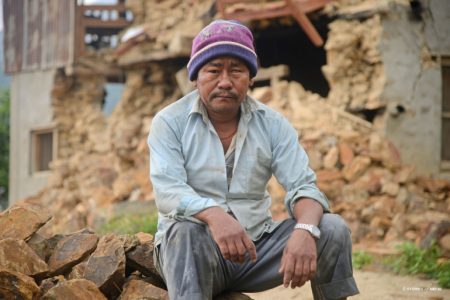
“I was sitting outside listening to the radio when it struck,” says Sanistaar, in Dhadhing, in one of the Stories of Nepal. The kids were watching TV since it was a Saturday.” Photo: Jaydev Poudyal, Stories of Nepal (used with permission)
POUDYAL’S ADDICTIONS also had a huge impact on the relationship he had with his wife, who stood by him through his darkest moments. He spoke warmly and frequently of his appreciation of her. “Back then I was looking for some sort of security for the future, and I was going to drink and there had to be somebody to take care of me.” It must feel like beginning an entirely new relationship now, following that ordeal, I suggest to him. “Exactly, I was never capable to love, or be loved, and complained no one loved me and no one cared. If someone came to help me I would shut myself from them.
“So I think what I’ve been through helped me collect these stories, because in Nepal there are many problems, lots of sorrow, lots of grief. People are poor and they have struggles every day. So, when I listen to them, I can relate because I’ve been there in suffering. I know how it is to be afraid and be down and depressed. I’ve seen that shit, right? I think it’s easier for me to understand. I don’t think Stories of Nepal would be there without my past.”
Poudyal was not the driven individual he could possibly have been. The blog was not an attempt at fame or fortune, or a personal challenge to attain likes and shares. It was all beginning to make sense. I told him so. “Getting a story is not a job, it’s not a mission,” he said. “It comes from a genuine want to talk to the other person and understand them. As soon at the other person sees that, they are willing to open up more. It’s also me sharing my fears and my struggles, it’s a two-way process.
“Sometimes I pursue a story-teller for months, sometimes a story can happen in an hour, sometimes I am walking with the person for days and then I talk to them.”
“How do I get such touching stories? That’s what I do. After I have breakfast, I take my camera and walk. I go everywhere. If I talk to ten people, maybe I get five that I like and maybe there are only three pictures I really like for the blog. Sometimes I pursue a story-teller for months, sometimes a story can happen in an hour, sometimes I am walking with the person for days and then I talk to them. Through all these entire dialogues of conversation I choose a part that’s really touched me.”
I admit to Poudyal that I didn’t expect such depth in his answers to my questions, based on the many other interviews I had read of him in the international press, which tended to focus on the more technical aspects of his work. “I get so many questions: how did Stories of Nepal start? How do you get stories? Sometimes I feel like, can I write the questions for you, so you know what would make those questions better? Can I?” he laughs. “I want to say that to the interviewer, but I can’t be rude, right?”
How often does he get interviewed? “Oh, a lot, a lot,” he replied. “I like to talk, and one of the times I really get to share is through interviews, and I am really not looking for my thoughts to be printed or published, but I want to be nice. If someone likes Stories of Nepal and they want to spend their time talking to me, I shouldn’t say no. I am not really the interview kind of guy, I have made myself aware of the fact that because Stories of Nepal is appreciated, it’s my duty to.
“All the Nepali newspapers have interviewed me, and the LA Times, the Gulf Times, even this fashion magazine, Grazia from Germany. But I always know that if these things were not to happen I’d still be doing Stories of Nepal.”
Even if you still only had those 10 Facebook likes you started with, I ask? “Of course, of course,” he responded quickly. “This is the best thing, travelling, listening. Lots of people send me messages saying I inspired them. When I was on the streets I would be treated like a dog, now my life has changed, it feels very special, a gift given to me. I think a sense of gratitude keeps me going. I will go home tonight and I will pray, not for me—I’ve done that enough—I’ll pray for the well-being, happiness for other people. I’ll pray for you, I’ll pray for everyone. I’m really grateful.”
Poudyal pointed to his half-finished sandwich to illustrate his point. “I had disgusting food in rehab, the conditions were very terrible. They treated us like criminals. Because I ate such bad food, now this sandwich is a miracle for me. I’m so grateful for everything, there was one time when I wanted to jump off a cliff but now I’m looking forward to everyday life.”
We sat in silence for a minute, before it was broken by Poudyal. “I think you have enough for two interviews now,” he said, laughing. It was time for us to finish our appointment. I said I would pay the bill. No, he insisted, I was his guest. “I thought you were my guest?” I responded. Too late, he had grabbed the waiter. I took some photographs of him, which, perhaps in keeping with his character but still a little ironically, he was shy about. He even insisted on giving me a lift to my bus stop on his motorbike, on the way showing me the house he had grown up in, and telling me more about what I should see in Kathmandu during my stay. As we parted, I felt like we had known each other for a long time.
A wise friend once told me that you can see a hundred places in the world with one pair of eyes, or you can see one place in the world with a hundred pairs of eyes. Perhaps that is the power of projects like Stories of Nepal, one that journalists should take heed of. Too often our profession can see the excitement of the big events without narrowing our scope to explore them through the eyes and experiences of the hundreds of people affected by them. After all, our job should be to help people understand the world they are living in, and that’s not always easy when our subjects are given brief, walk-on parts, providing the lines we want them to provide, and filling in the gaps in our reports with the words we expect them to give us. And in learning about Stories of Nepal, I had found a story I did not expect to hear, but which made a lot of sense.

